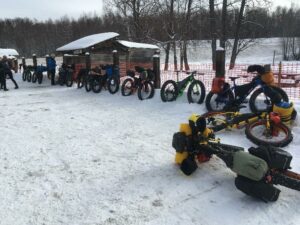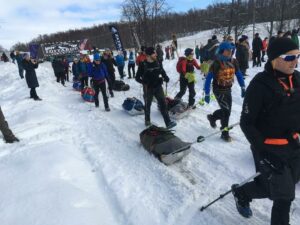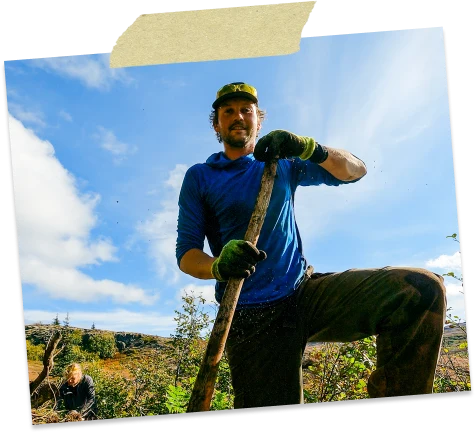Knik Lake- February 2017
Contributor: Dot Helm, Board Member – Mat-Su Trials and Parks Foundation
Trails mean different things to many people at different times. Slow and relaxing, or fast races. Some take a family walk, others race on them – dogs, snowmachines, and human powered (foot, ski, bike) – to mention just a few. The Iditarod National Historic Trail runs from Seward to Nome and has many connectors in the system, resulting in over 2000 miles of connected trails. Along the way are many villages, towns, and simple pull-offs. This human-powered race (Iditarod Trail Invitational) starts at Knik Lake one week before the dog-powered race to take advantage of the groomed trails where races overlap in normal years.
When I first started winter running for longer than an hour or so, I, like many newbies, was having trouble with water freezing. Someone on an internet group told me you couldn’t run far in winter because your water freezes. End of story. Hmm, I’d heard about race distances from 50k to 1000mi races. Seemed like the start of one of these races might be a good place to go learn about winter races – and keeping water drinkable and solid foods edible so they don’t break your teeth. And thus began a tradition for me of watching the starts of these human-powered races and see how equipment evolved. (I’m too slow to do them, but the starts are great places to meet people and learn.)
I headed down to Knik Lake in late February to do a pre-race slog on the Iditarod National Historic Trail. I was excited to see snow for the first time in several years on these trails – maybe a little deep and a little sloggy, like mashed potato topping, but decent base for cleats to dig into. I headed out the trail, listening to the dogs barking in the subdivision every time somebody goes by. Crossed the road, and watched the ravens playing in the sky. One surprised me from the rear when it dropped a piece of frozen ice or moss near me. Bad aim this time round, fortunately. Continued onward watching the differences in vegetation – small spruce in lowlands, more birch and cottonwood as the trees grow further up the hillsides. These first few miles are really pretty and relaxing (except in icy years). Before too long a moose crosses in front, and continued on its jog.
I turned around so I could get back in time for the race start. Bumped into a skier / musher I knew, and she gave me a heads up about a dog team silently catching up to me. Then another from the front. Then a few mountain bikers- probably heading out to cheer their friends on somewhere along the trail. Depending on snow, mode of travel, and other things, some people will ride bikes out maybe to Flathorn Lake, slower runners may run about 3 – 7 mi out. Some hang out along the trail waiting for friends, others head back for the start.
I arrived back at the lake to see people moving around, testing their bikes, sleds, and skis.
Everyone wishes their friends good luck / bon voyage before they line up to take off. The fastest bikes might take 2+ days to McGrath with good snow, while runners going to Nome might take 30 days. It’s a party!
And, yes, there are ways of keeping your water or drink from freezing up. What’s been interesting across the years is not just the change in equipment (many evolutions in water bottles or hydration bladders) and media (from simple text to interactive maps with details of each racer as they progress across the trail), but change from mostly mountain bikes to all fat-tire bikes of many brands (not just a few experimental ones). You see sleds that have been custom made and others purchased at a local store. This year the winner of the 350 mile foot race was using what looked like a toy sled. Last year’s rocks and ice (no snow) was hard on sleds – both expensive and low-cost. Carriers are more rugged and may have pockets, not just compactor bags. And shoes and traction devices have become more diverse – a great boon for everyone in snowy / icy country, not just long-distance races.
And so their journey begins as they fade into the distance across Knik Lake.
If you want to learn more visit – – http://www.iditarodtrailinvitational.com
Enjoy your trials this weekend!



EASIEST WAY TO DONATE For Alaskans
While applying for their PFD online, Alaskans can choose to Pick.Click.Give. in increments of $25. All donations are tax deductible and donors will receive tax documentation from the State once their donations have been processed. Permanent Fund Dividend applications are available from January 1 to March 31, though Alaskans may choose to add or adjust their pledges online through August 31.
Apply for Funding
Grants and Event Sponsorships
The Mat-Su Trails & Parks Foundation partners with organizations and local governments on projects and efforts that expand and enhance the valley’s network of trails and parks. Find out how we can help fund your next trail, park, or recreation project!
